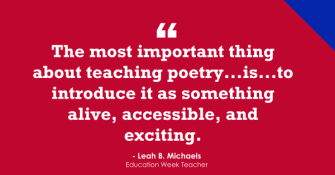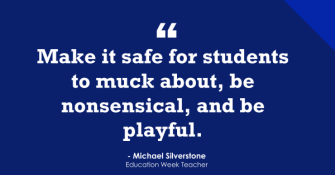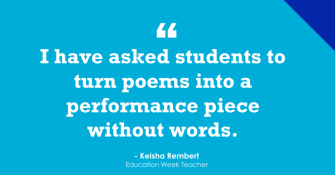(This is the second post in a three-part series. You can see Part One .)
The new question-of-the-week is:
What are your favorite ways to teach poetry?
After publishing 56—yes, count ‘em, 56—posts, videos, infographics, and podcasts over the past two months providing specific support to teachers dealing with the school closure crisis (you can see them all at ), I’m returning to “regularly scheduled programming.” These previously planned posts will include advice that is applicable to distance learning and teaching in the physical classroom.
In about a week, however, I will return to a series begun earlier this week on what schools should look like in the fall. After that series is complete, it will be back to the “usual” helpful posts—at least until we get a better idea of what the fall really looks like. At that point, I’ll start mixing specific advice on dealing with that new reality along with “regular” posts on teaching issues. During the summer, I’ll also be publishing my usual thematic posts organizing nine year’s worth of posts into more accessible collections.
By the way, next year will mark column’s 10th anniversary!
Today’s post continues a series with commentaries from Donna L. Shrum, Kelly Love, Gretchen Bernabei, Jennifer Casa-Todd, and Ashley McCall. You can listen to a I had with Donna, Kelly, Gretchen, and Jennifer on . You can also find a list of, and links to,
Georgia Heard, Leah B. Michaels, Michael Silverstone, and Keisha Rembert share their idea’s in today’s post.
“Poetry craft as toolboxes”
Georgia Heard received her MFA in poetry from Columbia University. She is a founding member of the Teachers College Reading and Writing Project where she worked as a lead staff developer in the N.Y.C. public schools for over 10 years. She is the author of numerous books including: Awakening the Heart: Exploring Poetry in Elementary and Middle School, which was selected by Instructor Magazine as one of the “12 Books Every Teacher Should Read.” Her newest collection for children is Boom! Bellow! Bleat!: Animal Poems for Two Or More Voices:
Here are my favorite ways to teach poetry:
Read a Poem Every Day
Students need to become friends with poetry. They need to know that poems can comfort them, make them laugh, help them remember, and nurture them to know and understand themselves, others, and the world around them more completely. When poetry is woven into the fabric of the everyday life of the classroom, it opens a window into a world outside of the classroom; it leads students to see the magic of the everyday, ordinary worlds all around them. Students begin to think in poetry, to speak poetry, and to read and write poetry naturally.
A Circle of Quiet Around a Poem
The best way to read a poem is to allow a circle of quiet to surround the poem. Let there be silence for a few beats after you finish reading. This will allow students to remain in the world of the poem and linger with the words, images, and feelings in their hearts and minds for a few minutes so they can fully experience the poem.
Model Writing a Poem
Modeling writing a poem in front of your students may seem scary, but it’s one of the most powerful invitations for young poets to write their own poems. By thinking out loud and writing our thoughts, we model the process of what it’s like to draft a poem. We can show our students that writing is about experimentation and that poets try on different words and take risks as we craft our poems. Be sure to keep your demonstration poem simple and short and write about something that matters to you and that you know your students might relate to.
Go for a Poetry Walk and See the World With Poets’ Eyes
Walk around the school building, go outside, even stroll around the classroom to see what students notice with their poets’ eyes. Students might use a clipboard or a notebook to write ideas down. After the walk, they can share their ideas as shared writing or they can write their own poems.
Introduce Poetry Craft as Toolboxes
A carpenter, like a poet, carries his or her tools to every job—nails, hammer, and screwdriver—just as a poet carries tools to the writing table. Explain to students that there is not just one poetry toolbox, but two, and they are both equally important and have two different purposes when writing a poem: The Sensory Toolbox contains sensory tools that help the reader imagine and visualize a poem such as imagery, metaphor, and personification, among many others. The second toolbox is the Music Toolbox consisting of those tools that help the reader experience the poem through sound such as rhyme, repetition, and alliteration, among many others. In the actual writing of a poem, meaning and sound are inseparable, but for the purposes of teaching poetic craft, it’s helpful to distinguish between the two.
Craft Is at the Service of the Heart
The purpose of learning about the tools of poetry is so that poets can better express what’s in their hearts and minds. As students begin to write their own poems, remind them that craft is always at the service of the heart.

Mimic writing
Leah B. Michaels, a national-board-certified teacher, has taught English, English as a second language, philosophy, and Theory of Knowledge to students from grades 6-12 in England, the Bahamas, and several schools in the United States. A proud union member, she is on the board of directors for the Montgomery County Education Association and serves as the English department chair at Richard Montgomery High School in Rockville, Md.:
I love poetry! One of my favorite ways to get students working with poetry is to have them write their own poems, using published poems as mentor texts. I like to start by selecting five poems that have something in common, such as a stanza structure or rhyme scheme, or a shared theme and/or motif. Students work together in small groups to read through all of the selected poems and have an informal conversation about which ones they like and why. Ultimately, each student chooses one poem to imitate.
The assignment is to mirror the chosen poem as closely as possible—line length, rhyme and/or meter, imagery, topic, etc. After some time composing their poems, students can break into various groups; for example, they can sit with others who chose the same poem they did or they can sit in a group of 3 to 5 where every student wrote a poem imitating a different poem. Either way, students can engage in rich discourse about their process of selecting the poem to work with and writing their own original poem.
This simple activity leads students organically into a discussion of authors’ choices in writing a poem, and groups will almost always have an aha moment of insight about the connections between form and content. What I love about this lesson is that it gives students an opportunity to read a variety of poems and talk poetry with a number of their peers, as well as to create their own original work in a context that feels low stakes because they are not exactly responsible for the form and content.
Some examples of collections I’ve created for this “imitation” assignment include poems that are about a specific time of day (e.g., “Morning” by Mary Oliver), whole collections by the same author (e.g., Clint Smith’s “What the ____ Said to the Black Boy” poems from his collection Counting Descent), or poems with a particular motif, such as fruit, a particular animal, etc. As long as each poem is relatively short, with a style that seems accessible to your group of students, you can hardly go wrong. Poetry Foundation offers wonderful online , and on Twitter, Melissa Smith’s #TeachLivingPoets is a terrific starting point for finding fresh, relevant, contemporary poems students love to read. Once students find (or write!) *that* poem, the one that shows them they like poetry or can write a poem, they love to be challenged to bring poems the class can use as mentor texts for writing or poems they think would make a good lesson in analysis.
One of my favorite resources is Kristin Runyon’s set of poetry that I use as a model before sending students online or to the library to find a pair of poems to present to the class and another is the , an excellent source for students to explore on their own. The most important thing about teaching poetry in my opinion is not to be reductive and treat poetry as a vehicle for memorization of literary terms or as a form that is limited to certain topics or styles, but to introduce it as something alive, accessible, and exciting, that everyone can enjoy.

“Poets were the first hackers”
Michael Silverstone is a veteran primary-grades teacher and writer about education. His focus on intrinsic motivation, mindfulness, and creative expression led him, after 15 years as a 2nd grade teacher, to become a Montessori educator. He has been an American Montessori Society Emerging Leaders Fellow and is a staff member of the Montessori Elementary Education Teacher Training Collaborative, as well as a lower-elementary (ages 6-9) teacher at Wellan Montessori School near Boston. He is co-author with Dr. Debbie Zacarian of Teaching to Empower (ASCD, March 2020):
If we consider ‘“systems” of written and spoken words as the original worldwide web, poets were the first hackers—using poetry, individuals could share new ways of seeing, feeling, describing, and reimagining the world in ways that helped them see beyond the conventions of their times. Teaching students to explore, interpret, or write poetry is a potentially emancipatory action that offers them a way to develop tools for seeing, noticing, evaluating, questioning in order to see possibilities they might not otherwise identify.
In George Orwell’s dystopian novel 1984, the use of “Newspeak,” a simplified language of government and bureaucrats, made the ability of individuals to describe, challenge, imagine, or even dissent literally unthinkable. Teaching poetry is the opposite—an expansion of language in order to create more space for freedom, creativity, and emotional honesty and shared awareness, thank goodness!
Here are a few of the favorite teaching strategies that my co-teachers and I like to use to teach poetry:
Help students build a poetry toolbox:
- Introduce multiple poetic forms such as acrostics, sestinas, limericks, list poems, haiku, concrete (shape) poems. A great source for information on the teaching of poetry and imaginative writing is
- Encourage play. Offer many choices of form allowing them creative room to experiment.
- Offer students multiple opportunities to share their writing with a school audience in a poetry slam or printed or online or anthology.
Support students in articulating what they notice in a poem:
- Foster whole-class and small-group discussions where students consider a poem and simply share things they notice.
- Acknowledge and value any observation that students can “back up” by citing the text.
- Facilitate by restating the observations verbally and/or recording them on chart paper. In this way, students develop a habit of articulating and sharing close readings with others, while having their thoughts validated so that confidence grows that it is safe to share insights and build a community of collective insight and wisdom.
Explore feelings that come up in moments of quiet:
- Model and encourage writing that draws on nostalgia (e.g., “I remember” list poems) or explores the feelings students that have in the presence of the quiet or vastness of nature and the cosmos.
- Use poetry writing to help students recognize what they might experience when there is openness and space that their busy minds can rest in the mystery of what it is to be a human being.
Encourage divergent thinking:
- Invite students to combine words and ideas in novel and surprising ways.
- Have them make lists of verbs and nouns and create combinations of them that spark unexpected and specific vividness (such as a “dangerous toothbrush” or a “knowledgeable ostrich”) and use them in their poems.
- Practice and encourage metaphor—the process of finding similarities between two otherwise unrelated things.
Encourage play:
- Make it safe for students to muck about, be nonsensical, and be playful. This takes attention to detail in how you set a tone in offering feedback and appreciation to writers and how you guide and model student/partner and group interactions. The foundation of creative courage is a sense of safety for who we are so we can invite in expressions of our unique and playful ways of seeing.

“Making poetry visual”
Keisha Rembert is an 8th grade English and U.S. history teacher at Clifford Crone Middle School in Naperville, Ill. Keisha feeds her love of learning by continually refining her craft and has been the recipient of several grants affording her the opportunity to take courses at some of the world’s most renowned universities. She was named Illinois’ History Teacher of the Year for 2019:
I love making poetry visual. I have turned my classroom into a jungle with poetry lines hanging from the vines. I have asked students to turn poems into a performance piece without words. I have asked students to connect poems to the design-thinking process by first asking students what is the poem “selling”? Happiness, fear, longevity. Then asking them to create a unique product that best captures the idea the poem seeks to convey. This activity engages students to reconsider how they think about and approach poetry. I find they appreciate the text because they are designing around it and have to thoroughly dissect it to create their product.

Thanks to Georgia, Leah, Michael, and Keisha for their contributions!
Please feel free to leave a comment with your reactions to the topic or directly to anything that has been said in this post.
Consider contributing a question to be answered in a future post. You can send one to me at lferlazzo@epe.org. When you send it in, let me know if I can use your real name if it’s selected or if you’d prefer remaining anonymous and have a pseudonym in mind.
You can also contact me on Twitter at .
�����ܹ���̳ has published a collection of posts from this blog, along with new material, in an e-book form. It’s titled .
Just a reminder; you can subscribe and receive updates from this blog via or And if you missed any of the highlights from the first eight years of this blog, you can see a categorized list below. The list doesn’t include ones from this current year, but you can find those by clicking on the “answers” category found in the sidebar.
I am also creating a .
